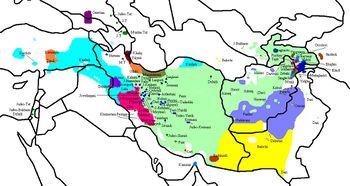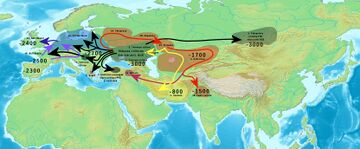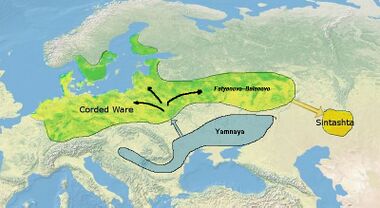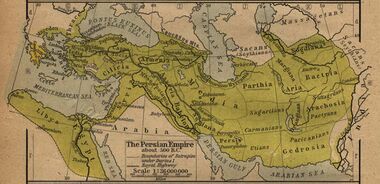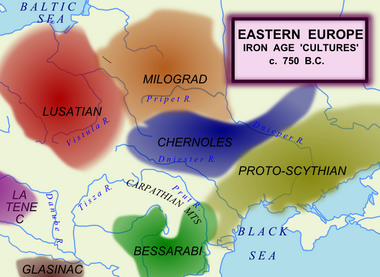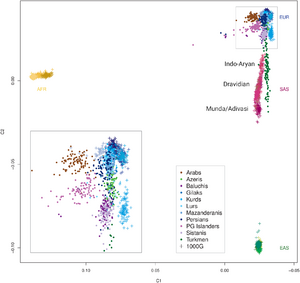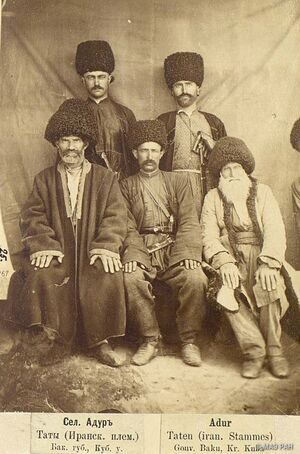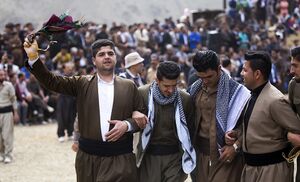الشعوب الإيرانية
| المناطق ذات التجمعات المعتبرة | |||||||||||||||||||||||||||||||
|---|---|---|---|---|---|---|---|---|---|---|---|---|---|---|---|---|---|---|---|---|---|---|---|---|---|---|---|---|---|---|---|
| إيران والهضبة الإيرانية، الأناضول، جنوب آسيا، آسيا الوسطى، القوقاز وكجاليات مهاجرة في أمريكا الشمالية وغرب اوروپا. | |||||||||||||||||||||||||||||||
| اللغات | |||||||||||||||||||||||||||||||
| اللغات الإيرانية، فرع من عائلة اللغة الهندو اوروپية. | |||||||||||||||||||||||||||||||
| الدين | |||||||||||||||||||||||||||||||
| الغالبية من المسلمين الشيعة والسنة، المسيحين الأرثوذكس،[1] زرداشتية، الأرثوذكسية الگيورگية، النسطورية، اليهودية، الإلحاد، الإحيائية، البهائية، الپروتستانتية، الكاثوليكية | |||||||||||||||||||||||||||||||
| الجماعات العرقية ذات الصلة | |||||||||||||||||||||||||||||||
| شعوب هندو-إيرانية أخرى | |||||||||||||||||||||||||||||||
الشعوب الإيرانية Iranian people[3] أو الإيرانيون، هي جماعة عرقية لسانية تاريخية، تتكون من متحدثي اللغات الإيرانية،[4] فرع رئيسي من عائلة اللغات الهندية-الاوروپية. وكانت هذه الشعوب تستوطن الهضبة الإيرانية وبصفة أساسية في إيران، بعض أماكن في آسيا الوسطى مثل أفغانستان، طاجيكستان، أجزاء من العراق، تركيا، پاكستان وأجزاء متفرقة من جبال القوقاز. [5][6] وتنتشر الشعوب الإيرانية في العصر الحديث في الهضبة الإيرانية، من الاندوس شرقا إلى وسط الأناضول غربا، ومن آسيا الوسطى والقوقاز إلى الخليج العربي - المكان الذي يسميه بعض العلماء أحيانا بالقارة الثقافية الإيرانية، أو فارس العظمى، ممثلا مدى انتشار وتوزيع اللغة الإيرانية في الإمبراطورية الفارسية.[7]
يـُعتقد أن الإيرانيون الأوائل بزغوا كفرع مستقل من الهندو-إيرانيين في آسيا الوسطى حول منتصف الألفية الثانية ق.م.[8][9] في ذروة توسعهم في منتصف الألفية الأولى ق.م.، امتدت أراضي الشعوب الإيرانية عبر السهوب الأوراسية بأكملها، من السهل المجري الكبير في الغرب إلى هضبة أوردوس في الشرق والهضبة الإيرانية في الجنوب.[10]
The ancient Iranian peoples who emerged after the 1st millennium BC include the Alans, the Bactrians, the Dahae, the Khwarazmians, the Massagetae, the Medes, the Parthians, the Persians, the Sagartians, the Sakas, the Sarmatians, the Scythians, the Sogdians, and likely the Cimmerians, among other Iranian-speaking peoples of Western Asia, Central Asia, Eastern Europe, and the Eastern Steppe.
In the 1st millennium AD, their area of settlement, which was mainly concentrated in the steppes and deserts of Eurasia,[11] was significantly reduced as a result of Slavic, Germanic, Turkic, and Mongolic expansions; many were subjected to Slavicization[12][13][14][15] and Turkification.[16][17] Modern Iranian peoples include the Baloch, the Gilaks, the Kurds, the Lurs, the Mazanderanis, the Ossetians, the Pamiris, the Pashtuns, the Persians, the Tats, the Tajiks, the Talysh, the Wakhis, the Yaghnobis, and the Zazas. Their current distribution spreads across the Iranian Plateau, stretching from the Caucasus in the north to the Persian Gulf in the south and from eastern Anatolia in the west to western Xinjiang in the east—a region that is sometimes called the Iranian Cultural Continent,[18] representing the extent of the Iranian-speakers and the significant influence of the Iranian peoples through the geopolitical and cultural reach of Greater Iran.[19]
التسمية
The term Iran derives directly from Middle Persian Ērān / AEran (𐭠𐭩𐭥𐭠𐭭) and Parthian Aryān.[20] The Middle Iranian terms ērān and aryān are oblique plural forms of gentilic ēr- (in Middle Persian) and ary- (in Parthian), both deriving from Old Persian ariya- (𐎠𐎼𐎡𐎹), Avestan airiia- (𐬀𐬌𐬭𐬌𐬌𐬀) and Proto-Iranian *arya-.[20][21]
There have been many attempts to qualify the verbal root of ar- in Old Iranian arya-. The following are according to 1957 and later linguists:
- Emmanuel Laroche (1957): ara- "to fit" ("fitting", "proper").
Old Iranian arya- being descended from Proto-Indo-European ar-yo-, meaning "(skillfully) assembler".[22] - Georges Dumézil (1958): ar- "to share" (as a union).
- Harold Walter Bailey (1959): ar- "to beget" ("born", "nurturing").
- Émil Benveniste (1969): ar- "to fit" ("companionable").
Unlike the Sanskrit ārya- (Aryan), the Old Iranian term has solely an ethnic meaning.[23][24] Today, the Old Iranian arya- remains in ethno-linguistic names such as Iran, Alan, Ir, and Iron.[25][20][26][27]
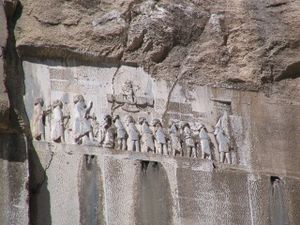
In the Iranian languages, the gentilic is attested as a self-identifier included in ancient inscriptions and the literature of Avesta.[28][أ] The earliest epigraphically attested reference to the word arya- occurs in the Bistun Inscription of the 6th century BC. The inscription of Bistun (or Behistun; الفارسية القديمة: Bagastana) describes itself to have been composed in Arya [language or script]. As is also the case for all other Old Iranian language usage, the arya of the inscription does not signify anything but Iranian.[29]
In royal Old Persian inscriptions, the term arya- appears in three different contexts:[24][25]
- As the name of the language of the Old Persian version of the inscription of Darius I in the Bistun Inscription.
- As the ethnic background of Darius the Great in inscriptions at Rustam Relief and Susa (Dna, Dse) and the ethnic background of Xerxes I in the inscription from Persepolis (Xph).
- As the definition of the God of Iranians, Ohrmazd, in the Elamite version of the Bistun Inscription.
In the Dna and Dse, Darius and Xerxes describe themselves as "an Achaemenid, a Persian, son of a Persian, and an Aryan, of Aryan stock".[30] Although Darius the Great called his language arya- ("Iranian"),[30] modern scholars refer to it as Old Persian[30] because it is the ancestor of the modern Persian language.[31]
The trilingual inscription erected by the command of Shapur I gives a more clear description. The languages used are Parthian, Middle Persian, and Greek. In Greek inscription says "ego ... tou Arianon ethnous despotes eimi", which translates to "I am the king of the kingdom (nation) of the Iranians". In Middle Persian, Shapur says "ērānšahr xwadāy hēm" and in Parthian he says "aryānšahr xwadāy ahēm".[24][32]
The Avesta clearly uses airiia- as an ethnic name (Videvdat 1; Yasht 13.143–44, etc.), where it appears in expressions such as airyāfi daiŋˊhāvō ("Iranian lands"), airyō šayanəm ("land inhabited by Iranians"), and airyanəm vaējō vaŋhuyāfi dāityayāfi ("Iranian stretch of the good Dāityā").[24] In the late part of the Avesta (Videvdat 1), one of the mentioned homelands was referred to as Airyan'əm Vaējah which approximately means "expanse of the Iranians". The homeland varied in its geographic range, the area around Herat (Pliny's view) and even the entire expanse of the Iranian Plateau (Strabo's designation).[33]
The Old Persian and Avestan evidence is confirmed by the Greek sources.[24] Herodotus, in his Histories, remarks about the Iranian Medes that "Medes were called anciently by all people Arians" (7.62).[24][25] In Armenian sources, the Parthians, Medes and Persians are collectively referred to as Iranians.[34] Eudemus of Rhodes (Dubitationes et Solutiones de Primis Principiis, in Platonis Parmenidem) refers to "the Magi and all those of Iranian (áreion) lineage". Diodorus Siculus (1.94.2) considers Zoroaster (Zathraustēs) as one of the Arianoi.[24]
Strabo, in his Geographica (1st century AD), mentions of the Medes, Persians, Bactrians and Sogdians of the Iranian Plateau and Transoxiana of antiquity:[35]
The name of Ariana is further extended to a part of Persia and of Media, as also to the Bactrians and Sogdians on the north; for these speak approximately the same language, with but slight variations.
— Geographica, 15.8
The Bactrian (a Middle Iranian language) inscription of Kanishka (the founder of the Kushan Empire) at Rabatak, which was discovered in 1993 in an unexcavated site in the Afghan province of Baghlan, clearly refers to this Eastern Iranian language as Arya.[36]
All this evidence shows that the name Arya was a collective definition, denoting peoples who were aware of belonging to the one ethnic stock, speaking a common language, and having a religious tradition that centered on the cult of Ohrmazd.[24]
The academic usage of the term Iranian is distinct from the state of Iran and its various citizens (who are all Iranian by nationality), in the same way that the term Germanic peoples is distinct from Germans. Some inhabitants of Iran are not necessarily ethnic Iranians by virtue of not being speakers of Iranian languages.
Iranian vs. Iranic
Some scholars such as John Perry prefer the term Iranic as the anthropological name for the linguistic family and ethnic groups of this category (many of which exist outside Iran), while Iranian for anything about the country Iran. He uses the same analogue as in differentiating German from Germanic or differentiating Turkish and Turkic.[37] German scholar Martin Kummel also argues the same distinction of Iranian from Iranic.[38]
التاريخ والاستيطان
الجذور الهندو-أوروپية
Proto-Indo-Iranians
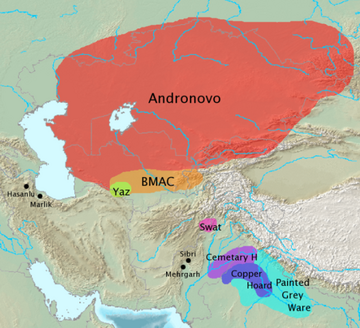
The Proto-Indo-Iranians are commonly identified with the Sintashta culture and the subsequent Andronovo culture within the broader Andronovo horizon, and their homeland with an area of the Eurasian steppe that borders the Ural River on the west and the Tian Shan on the east.
The Indo-Iranian migrations took place in two waves.[39][40] The first wave consisted of the Indo-Aryan migration through the Bactria-Margiana Culture, also called "Bactria-Margiana Archaeological Complex," into the Levant, founding the Mittani kingdom; and a migration south-eastward of the Vedic people, over the Hindu Kush into northern India.[41] The Indo-Aryans split off around 1800–1600 BC from the Iranians,[42] whereafter they were defeated and split into two groups by the Iranians,[43] who dominated the Central Eurasian steppe zone[44] and "chased [the Indo-Aryans] to the extremities of Central Eurasia."[44] One group were the Indo-Aryans who founded the Mitanni kingdom in northern Syria;[45] (c. 1500–1300 BC) the other group were the Vedic people.[46] Christopher I. Beckwith suggests that the Wusun, an Indo-European Caucasian people of Inner Asia in antiquity, were also of Indo-Aryan origin.[47]
The second wave is interpreted as the Iranian wave,[48] and took place in the third stage of the Indo-European migrations[41] from 800 BC onwards.
Sintashta–Petrovka culture
The Sintashta culture, also known as the Sintashta–Petrovka culture[49] or Sintashta–Arkaim culture,[50] is a Bronze Age archaeological culture of the northern Eurasian steppe on the borders of Eastern Europe and Central Asia, dated to the period 2100–1800 BC.[51] It is probably the archaeological manifestation of the Indo-Iranian language group.[52]
The Sintashta culture emerged from the interaction of two antecedent cultures. Its immediate predecessor in the Ural-Tobol steppe was the Poltavka culture, an offshoot of the cattle-herding Yamnaya horizon that moved east into the region between 2800 and 2600 BC. Several Sintashta towns were built over older Poltavka settlements or close to Poltavka cemeteries, and Poltavka motifs are common on Sintashta pottery. Sintashta material culture also shows the influence of the late Abashevo culture, a collection of Corded Ware settlements in the forest steppe zone north of the Sintashta region that were also predominantly pastoralist.[53] Allentoft et al. (2015) also found close autosomal genetic relationship between peoples of Corded Ware culture and Sintashta culture.[54]
The earliest known chariots have been found in Sintashta burials, and the culture is considered a strong candidate for the origin of the technology, which spread throughout the Old World and played an important role in ancient warfare.[55] Sintashta settlements are also remarkable for the intensity of copper mining and bronze metallurgy carried out there, which is unusual for a steppe culture.[56]
Because of the difficulty of identifying the remains of Sintashta sites beneath those of later settlements, the culture was only recently distinguished from the Andronovo culture.[50] It is now recognised as a separate entity forming part of the 'Andronovo horizon'.[49]
Andronovo culture
The Andronovo culture is a collection of similar local Bronze Age Indo-Iranian cultures that flourished c. 1800–900 BC in western Siberia and the west Asiatic steppe.[57] It is probably better termed an archaeological complex or archaeological horizon. The name derives from the village of Andronovo (55°53′N 55°42′E / 55.883°N 55.700°E), where in 1914, several graves were discovered, with skeletons in crouched positions, buried with richly decorated pottery. The older Sintashta culture (2100–1800), formerly included within the Andronovo culture, is now considered separately, but regarded as its predecessor, and accepted as part of the wider Andronovo horizon. At least four sub-cultures of the Andronovo horizon have been distinguished, during which the culture expands towards the south and the east:
- Sintashta-Petrovka-Arkaim (Southern Urals, northern Kazakhstan, 2200–1600 BC)
- the Sintashta fortification of ca. 1800 BC in Chelyabinsk Oblast
- the Petrovka settlement fortified settlement in Kazakhstan
- the nearby Arkaim settlement dated to the 17th century
- Alakul (2100–1400 BC) between Oxus and Jaxartes, Kyzylkum desert
- Alekseyevka (1300–1100 BC "final Bronze") in eastern Kazakhstan, contacts with Namazga VI in Turkmenia
- Ingala Valley in the south of the Tyumen Oblast
- Fedorovo (1500–1300 BC) in southern Siberia (earliest evidence of cremation and fire cult)[58]
The geographical extent of the culture is vast and difficult to delineate exactly. On its western fringes, it overlaps with the approximately contemporaneous, but distinct, Srubna culture in the Volga-Ural interfluvial. To the east, it reaches into the Minusinsk depression, with some sites as far west as the southern Ural Mountains,[59] overlapping with the area of the earlier Afanasevo culture.[60] Additional sites are scattered as far south as the Koppet Dag (Turkmenistan), the Pamir (Tajikistan) and the Tian Shan (Kyrgyzstan). The northern boundary vaguely corresponds to the beginning of the Taiga.[59] In the Volga basin, interaction with the Srubna culture was the most intense and prolonged, and Federovo style pottery is found as far west as Volgograd.
Most researchers associate the Andronovo horizon with early Indo-Iranian languages, though it may have overlapped the early Uralic-speaking area at its northern fringe.
Scythians and Persians
From the late 2nd millennium BC to early 1st millennium BC the Iranians had expanded from the Eurasian Steppe, and Iranian peoples such as Medes, Persians, Parthians and Bactrians populated the Iranian Plateau.[61][62]
Scythian tribes, along with Cimmerians, Sarmatians and Alans populated the steppes north of the Black Sea. The Scythian and Sarmatian tribes were spread across Great Hungarian Plain, South-Eastern Ukraine, Russias Siberian, Southern, Volga,[63] Uralic regions and the Balkans,[64][65][66] while other Scythian tribes, such as the Saka, spread as far east as Xinjiang, China.
Western and Eastern Iranians
The division into an "Eastern" and a "Western" group by the early 1st millennium is visible in Avestan vs. Old Persian, the two oldest known Iranian languages. The Old Avestan texts known as the Gathas are believed to have been composed by Zoroaster, the founder of Zoroastrianism, with the Yaz culture (c. 1500 BC – 1100 BC) as a candidate for the development of Eastern Iranian culture.[بحاجة لمصدر]
الشعوب الإيرانية الغربية


During the 1st centuries of the 1st millennium BC, the ancient Persians established themselves in the western portion of the Iranian Plateau and appear to have interacted considerably with the Elamites and Babylonians, while the Medes also entered in contact with the Assyrians.[67] Remnants of the Median language and Old Persian show their common Proto-Iranian roots, emphasized in Strabo and Herodotus' description of their languages as very similar to the languages spoken by the Bactrians and Sogdians in the east.[33][68] Following the establishment of the Achaemenid Empire, the Persian language (referred to as "Farsi" in Persian) spread from Pars or Fars Province to various regions of the Empire, with the modern dialects of Iran, Afghanistan (also known as Dari) and Central-Asia (known as Tajiki) descending from Old Persian.
At first, the Western Iranian peoples in the Near East were dominated by the various Assyrian empires. An alliance of the Medes with the Persians, and rebelling Babylonians, Scythians, Chaldeans, and Cimmerians, helped the Medes to capture Nineveh in 612 BC, which resulted in the eventual collapse of the Neo-Assyrian Empire by 605 BC.[69] The Medes were subsequently able to establish their Median kingdom (with Ecbatana as their royal centre) beyond their original homeland and had eventually a territory stretching roughly from northeastern Iran to the Halys River in Anatolia. After the fall of the Assyrian Empire, between 616 BC and 605 BC, a unified Median state was formed, which, together with Babylonia, Lydia, and Egypt, became one of the four major powers of the ancient Near East
Later on, in 550 BC, Cyrus the Great, would overthrow the leading Median rule, and conquer Kingdom of Lydia and the Babylonian Empire after which he established the Achaemenid Empire (or the First Persian Empire), while his successors would dramatically extend its borders. At its greatest extent, the Achaemenid Empire would encompass swaths of territory across three continents, namely Europe, Africa and Asia, stretching from the Balkans and Eastern Europe proper in the west, to the Indus Valley in the east. The largest empire of ancient history, with their base in Persis (although the main capital was located in Babylon) the Achaemenids would rule much of the known ancient world for centuries. This First Persian Empire was equally notable for its successful model of a centralised, bureaucratic administration (through satraps under a king) and a government working to the profit of its subjects, for building infrastructure such as a postal system and road systems and the use of an official language across its territories and a large professional army and civil services (inspiring similar systems in later empires),[70] and for emancipation of slaves including the Jewish exiles in Babylon, and is noted in Western history as the antagonist of the Greek city states during the Greco-Persian Wars. The Mausoleum at Halicarnassus, one of the Seven Wonders of the Ancient World, was built in the empire as well.
The Greco-Persian Wars resulted in the Persians being forced to withdraw from their European territories, setting the direct further course of history of Greece and the rest of Europe. More than a century later, a prince of Macedon (which itself was a subject to Persia from the late 6th century BC up to the First Persian invasion of Greece) later known by the name of Alexander the Great, overthrew the incumbent Persian king, by which the Achaemenid Empire was ended.
Old Persian is attested in the Behistun Inscription (c. 519 BC), recording a proclamation by Darius the Great.[71] In southwestern Iran, the Achaemenid kings usually wrote their inscriptions in trilingual form (Elamite, Babylonian and Old Persian)[72] while elsewhere other languages were used. The administrative languages were Elamite in the early period, and later Imperial Aramaic,[73] as well as Greek, making it a widely used bureaucratic language.[74] Even though the Achaemenids had extensive contacts with the Greeks and vice versa, and had conquered many of the Greek-speaking area's both in Europe and Asia Minor during different periods of the empire, the native Old Iranian sources provide no indication of Greek linguistic evidence.[74] However, there is plenty of evidence (in addition to the accounts of Herodotus) that Greeks, apart from being deployed and employed in the core regions of the empire, also evidently lived and worked in the heartland of the Achaemenid Empire, namely Iran.[74] For example, Greeks were part of the various ethnicities that constructed Darius' palace in Susa, apart from the Greek inscriptions found nearby there, and one short Persepolis tablet written in Greek.[74]
The early inhabitants of the Achaemenid Empire appear to have adopted the religion of Zoroastrianism.[75] The Baloch who speak a west Iranian language relate an oral tradition regarding their migration from Aleppo, Syria around the year 1000 AD, whereas linguistic evidence links Balochi to Kurmanji, Soranî, Gorani and Zazaki language.[76]
الشعوب الإيرانية الشرقية
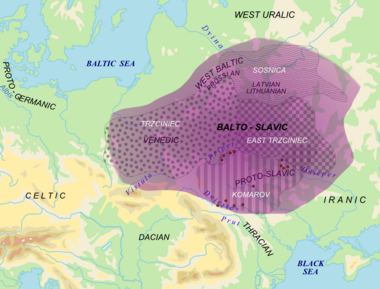
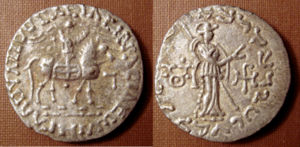
While the Iranian tribes of the south are better known through their texts and modern counterparts, the tribes which remained largely in the vast Eurasian expanse are known through the references made to them by the ancient Greeks, Persians, Chinese, and Indo-Aryans as well as by archaeological finds. The Greek chronicler, Herodotus (5th century BC) makes references to a nomadic people, the Scythians; he describes them as having dwelt in what is today southern European Russia and Ukraine. He was the first to make a reference to them. Many ancient Sanskrit texts from a later period make references to such tribes they were witness of pointing them towards the southeasternmost edges of Central Asia, around the Hindukush range in northern Pakistan.
It is believed that these Scythians were conquered by their eastern cousins, the Sarmatians, who are mentioned by Strabo as the dominant tribe which controlled the southern Russian steppe in the 1st millennium AD. These Sarmatians were also known to the Romans, who conquered the western tribes in the Balkans and sent Sarmatian conscripts, as part of Roman legions, as far west as Roman Britain. These Iranian-speaking Scythians and Sarmatians dominated large parts of Eastern Europe for a millennium, and were eventually absorbed and assimilated (e.g. Slavicisation) by the Proto-Slavic population of the region.[12][13][15]
The Sarmatians differed from the Scythians in their veneration of the god of fire rather than god of nature, and women's prominent role in warfare, which possibly served as the inspiration for the Amazons.[77] At their greatest reported extent, around the 1st century AD, these tribes ranged from the Vistula River to the mouth of the Danube and eastward to the Volga, bordering the shores of the Black and Caspian Seas as well as the Caucasus to the south.[78] Their territory, which was known as Sarmatia to Greco-Roman ethnographers, corresponded to the western part of greater Scythia (mostly modern Ukraine and Southern Russia, also to a smaller extent north eastern Balkans around Moldova). According to authors Arrowsmith, Fellowes and Graves Hansard in their book A Grammar of Ancient Geography published in 1832, Sarmatia had two parts, Sarmatia Europea[79] and Sarmatia Asiatica[80] covering a combined area of 503,000 sq mi or 1,302,764 km2.
Throughout the 1st millennium AD, the large presence of the Sarmatians who once dominated Ukraine, Southern Russia, and swaths of the Carpathians, gradually started to diminish mainly due to assimilation and absorption by the Germanic Goths, especially from the areas near the Roman frontier, but only completely by the Proto-Slavic peoples. The abundant East Iranian-derived toponyms in Eastern Europe proper (e.g. some of the largest rivers; the Dniestr and Dniepr), as well as loanwords adopted predominantly through the Eastern Slavic languages and adopted aspects of Iranian culture amongst the early Slavs, are all a remnant of this. A connection between Proto-Slavonic and Iranian languages is also furthermore proven by the earliest layer of loanwords in the former.[81] For instance, the Proto-Slavonic words for god (*bogъ), demon (*divъ), house (*xata), axe (*toporъ) and dog (*sobaka) are of Scythian origin.[82]
The extensive contact between these Scytho-Sarmatian Iranian tribes in Eastern Europe and the (Early) Slavs included religion. After Slavic and Baltic languages diverged the Early Slavs interacted with Iranian peoples and merged elements of Iranian spirituality into their beliefs. For example, both Early Iranian and Slavic supreme gods were considered givers of wealth, unlike the supreme thunder gods in many other European religions. Also, both Slavs and Iranians had demons –- given names from similar linguistic roots, Daêva (Iranian) and Divŭ (Slavic) –- and a concept of dualism, of good and evil.[83]
The Sarmatians of the east, based in the Pontic–Caspian steppe, became the Alans, who also ventured far and wide, with a branch ending up in Western Europe and then North Africa, as they accompanied the Germanic Vandals and Suebi during their migrations. The modern Ossetians are believed to be the direct descendants of the Alans, as other remnants of the Alans disappeared following Germanic, Hunnic and ultimately Slavic migrations and invasions.[84] Another group of Alans allied with Goths to defeat the Romans and ultimately settled in what is now called Catalonia (Goth-Alania).[85]
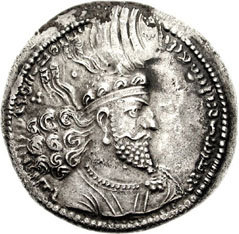
Some of the Saka-Scythian tribes in Central Asia would later move further southeast and invade the Iranian Plateau, large sections of present-day Afghanistan and finally deep into present day Pakistan (see Indo-Scythians). Another Iranian tribe related to the Saka-Scythians were the Parni in Central Asia, and who later become indistinguishable from the Parthians, speakers of a northwest-Iranian language. Many Iranian tribes, including the Khwarazmians, Massagetae and Sogdians, were assimilated and/or displaced in Central Asia by the migrations of Turkic tribes emanating out of Xinjiang and Siberia.[86]
The modern Sarikoli in southern Xinjiang and the Ossetians of the Caucasus (mainly South Ossetia and North Ossetia) are remnants of the various Scythian-derived tribes from the vast far and wide territory they once dwelled in. The modern Ossetians are the descendants of the Alano-Sarmatians,[87][88] and their claims are supported by their Northeast Iranian language, while culturally the Ossetians resemble their North Caucasian neighbors, the Kabardians and Circassians.[84][89] Various extinct Iranian peoples existed in the eastern Caucasus, including the Azaris, while some Iranian peoples remain in the region, including the Talysh[90] and the Tats[91] found in Azerbaijan and as far north as the Russian republic of Dagestan. A remnant of the Sogdians is found in the Yaghnobi-speaking population in parts of the Zeravshan valley in Tajikistan.
Later developments
The main migration of Turkic peoples occurred between the 6th and 10th centuries, when they spread across most of Central Asia. The Turkic peoples slowly replaced and assimilated the previous Iranian-speaking locals, turning the population of Central Asia from largely Iranian, into primarily of East Asian descent.[92]
Starting with the reign of Omar in 634 AD, Muslim Arabs began a conquest of the Iranian Plateau. The Arabs conquered the Sassanid Empire of the Persians and seized much of the Byzantine Empire populated by the Kurds and others. Ultimately, the various Iranian peoples, including the Persians, Pashtuns, Kurds and Balochis, converted to Islam, while the Alans converted to Christianity, thus laying the foundation for the fact that the modern-day Ossetians are Christian.[93] The Iranian peoples would later split along sectarian lines as the Persians adopted the Shi'a sect. As ancient tribes and identities changed, so did the Iranian peoples, many of whom assimilated foreign cultures and peoples.[94]
Later, during the 2nd millennium AD, the Iranian peoples would play a prominent role during the age of Islamic expansion and empire. Saladin, a noted adversary of the Crusaders, was an ethnic Kurd, while various empires centered in Iran (including the Safavids) re-established a modern dialect of Persian as the official language spoken throughout much of what is today Iran and the Caucasus. Iranian influence spread to the neighbouring Ottoman Empire, where Persian was often spoken at court (though a heavy Turko-Persian basis there was set already by the predecessors of the Ottomans in Anatolia, namely the Seljuks and the Sultanate of Rum amongst others) as well to the court of the Mughal Empire. All of the major Iranian peoples reasserted their use of Iranian languages following the decline of Arab rule, but would not begin to form modern national identities until the 19th and early 20th centuries.
الديموغرافيا
There are an estimated 150 to 200 million native speakers of Iranian languages, the six major groups of Persians, Lurs, Kurds, Tajiks, Baloch, and Pashtuns accounting for about 90% of this number.[95] Currently, most of these Iranian peoples live in Iran, Afghanistan, the Caucasus (mainly Ossetia, other parts of Georgia, Dagestan, and Azerbaijan), Iraqi Kurdistan and Kurdish majority populated areas of Turkey, Iran and Syria, Tajikistan, Pakistan and Uzbekistan. There are also Iranian peoples living in Eastern Arabia such as northern Oman, Bahrain, and Kuwait.
Due to recent migrations, there are also large communities of speakers of Iranian languages in Europe, the Americas.
| الشعب | المنطقة | السكان |
|---|---|---|
| الشعوب المتحدثة بالفارسية | Iran, Afghanistan, Tajikistan, Uzbekistan, Bahrain, Kuwait, Iraq | 72–85 |
| پشتون | پاكستان، أفغانستان | 35–50 |
| أكراد | تركيا، إيران، كردستان العراق، سوريا، أرمنيا | 28–35 |
Baluchis
Mir- Jat |
پاكستان، إيران، أفغانستان | 15–20 |
| Gilakis & Mazanderanis | Iran | 5–10 |
| Lurs & Bakhtiaris | Iran | 6 |
| Laks[96] | إيران | 0.5 |
| Pamiri people | طاجيكستان، أفغانستان، الصين، پاكستان | 0.9 |
| Talysh | أذربيجان، إيران | 0.5 |
| اوستيون | اوستيا الجنوبية، جورجيا، روسيا (اوستيا الشمالية)، المجر |
0.7 |
| Yaghnobi | Uzbekistan and Tajikistan (Zerafshan region) | 0.025 |
| Kumzari | عمان (Musandam) | 0.021 |
الثقافة
 مقالة مفصلة: فلسفة إيرانية
مقالة مفصلة: فلسفة إيرانية
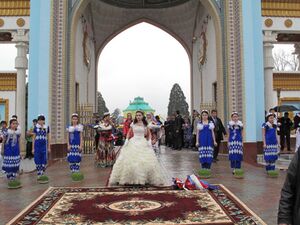
Iranian culture is today considered to be centered in what is called the Iranian Plateau, and has its origins tracing back to the Andronovo culture of the late Bronze Age, which is associated with other cultures of the Eurasian Steppe.[97][98] It was, however, later developed distinguishably from its earlier generations in the Steppe, where a large number of Iranian-speaking peoples (i.e., the Scythians) continued to participate, resulting in a differentiation that is displayed in Iranian mythology as the contrast between Iran and Turan.[97]
Like other Indo-Europeans, the early Iranians practiced ritual sacrifice, had a social hierarchy consisting of warriors, clerics, and farmers, and recounted their deeds through poetic hymns and sagas.[99] Various common traits can be discerned among the Iranian peoples. For instance, the social event of Nowruz is an ancient Iranian festival that is still celebrated by nearly all of the Iranian peoples. However, due to their different environmental adaptations through migration, the Iranian peoples embrace some degrees of diversity in dialect, social system, and other aspects of culture.[100]
With numerous artistic, scientific, architectural, and philosophical achievements and numerous kingdoms and empires that bridged much of the civilized world in antiquity, the Iranian peoples were often in close contact with people from various western and eastern parts of the world.
الديانات

The early Iranian peoples practiced the ancient Iranian religion, which, like that of other Indo-European peoples, embraced various male and female deities.[102] Fire was regarded as an important and highly sacred element, and also a deity. In ancient Iran, fire was kept with great care in fire temples.[102] Various annual festivals that were mainly related to agriculture and herding were celebrated, the most important of which was the New Year (Nowruz), which is still widely celebrated.[102] Zoroastrianism, a form of the ancient Iranian religion that is still practiced by some communities,[103] was later developed and spread to nearly all of the Iranian peoples living in the Iranian Plateau. Other religions that had their origins in the Iranian world were Mithraism, Manichaeism, and Mazdakism, among others. The various religions of the Iranian peoples are believed by some scholars to have been significant early philosophical influences on Christianity and Judaism.[104]
Nowadays, most Iranian people follow Islam (Sunnism, followed by Shi'ism), with minorities following Christianity, Judaism, Mandaeism, Iranian religions and various levels of irreligion.[بحاجة لمصدر]
الاندماج الثقافي
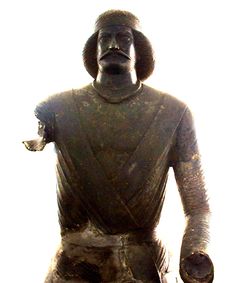
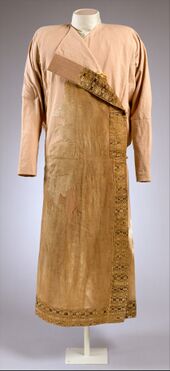
Iranian languages were and, to a lesser extent, still are spoken in a wide area comprising regions around the Black Sea, the Caucasus, Central Asia, Russia and the northwest of China.[105] This population was linguistically assimilated by smaller but dominant Turkic-speaking groups, while the sedentary population eventually adopted the Persian language, which began to spread within the region since the time of the Sasanian Empire.[105] The language-shift from Middle Iranian to Turkic and New Persian was predominantly the result of an "elite dominance" process.[106][107] Moreover, various Turkic-speaking ethnic groups of the Iranian Plateau are often conversant also in an Iranian language and embrace Iranian culture to the extent that the term Turko-Iranian would be applied.[108] A number of Iranian peoples were also intermixed with the Slavs,[13] and many were subjected to Slavicisation.[14][15]
The following either partially descend from or are sometimes regarded as descendants of the Iranian peoples.
- Turkic-speakers:
- Azerbaijanis: In spite of being native speakers of a Turkic language (Azerbaijani Turkic), they are believed to be primarily descended from the earlier Iranian-speakers of the region.[97][100][109][110][111] They are possibly related to the ancient Iranian tribe of the Medes, aside from the rise of the subsequent Persian and Turkic elements (changing of the native Iranian language) within their area of settlement,[112] which, prior to the spread of Turkic, was Iranian-speaking.[113] Thus, due to their historical, genetic and cultural ties to the Iranians,[114] the Azerbaijanis are often associated with the Iranian peoples. Genetic studies observed that they are also genetically related to the Iranian peoples.[115]
- Turkmens: Genetic studies show that the Turkmens are characterized by the presence of local Iranian mtDNA lineages, similar to the eastern Iranian populations, but modest female Mongoloid mtDNA components were observed in Turkmen populations with the frequencies of about 20%.[116]
- Uzbeks: The unique grammatical and phonetical features of the Uzbek language,[117] as well as elements within the modern Uzbek culture, reflect the older Iranian roots of the Uzbek people.[105][118][119][120] According to recent genetic genealogy testing from a University of Oxford study, the genetic admixture of the Uzbeks clusters somewhere between the Iranian peoples and the Mongols.[121] Prior to the Russian conquest of Central Asia, the local ancestors of the Turkic-speaking Uzbeks and the Persian-speaking Tajiks, both living in Central Asia, were referred to as Sarts, while Uzbek and Turk were the names given to the nomadic and semi-nomadic populations of the area. Still, as of today, modern Uzbeks and Tajiks are known to their Turkic neighbors, the Kazakhs and the Kyrgyz, as Sarts. Some Uzbek scholars also favor the Iranian origin theory.[122][صفحة مطلوبة] According to another study conducted in 2009, she claimed that Uzbeks and Central Asian Turkic peoples clustered genetically and were far from Iranian groups.[123]
- Uyghurs: Contemporary scholars consider modern Uyghurs to be the descendants of, apart from the ancient Uyghurs, the Iranian Saka (Scythian) tribes and other Indo-European peoples who inhabited the Tarim Basin before the arrival of the Turkic tribes.[124]
- Persian-speakers:
- The Hazaras are a Persian-speaking ethnic group native to, and primarily residing in, the mountainous region of Hazarajat, in central Afghanistan. Although the origins of the Hazara people have not been fully reconstructed, genetic analysis of the Hazara indicate partial Mongol ancestry. Invading Mongols and Turco-Mongols mixed with the local Iranian population. for example Qara'unas settled in what is now Afghanistan and mixed with the local populations. A second wave of mostly Chagatai Turco-Mongols came from Central Asia, associated with the Ilkhanate and the Timurids, all of whom settled in Hazarajat and mixed with the local population. Phenotype can vary, with some noting that certain Hazaras may resemble peoples native to the Iranian plateau.[125][126]
- Slavic-speakers:
- Croats and Serbs: Some scholars suggest that the Slavic-speaking Serbs and Croats are descended from the ancient Sarmatians,[127][128] an ancient Iranian people who once settled in most of southern European Russia and the eastern Balkans, and that their ethnonyms are of Iranian origin. It is proposed that the Sarmatian Serboi and alleged Horoathos tribes were assimilated with the numerically superior Slavs, passing on their name. Iranian-speaking peoples did inhabit parts of the Balkans in late classical times, and would have been encountered by the Slavs. However, direct linguistic, historical, or archaeological proof for such a theory is lacking. [ب]
- Swahili-speakers:
- Shirazis: The Shirazi are a sub-group of the Swahili people living on the Swahili coast of East Africa, especially on the islands of Zanzibar, Pemba, and Comoros. Local traditions about their origin claim they are descended from merchant princes from Shiraz in Iran who settled along the Swahili coast.
- Indo-Aryan speakers:
- Sindhis: Though today the Balochis are only 3.6% of Sindh's population, the population is actually higher, nearly 40%, most of whom don't speak Balochi anymore.[129] Many Balochis such as the Zardaris and the African Baloch Makranis came to Sindh to find jobs and eventually founded the city of Karachi.[130] The Talpur Dynasty was an ethnic Baloch Sindhi speaking dynasty that ruled much of Sindh and parts of Balochistan during the British colonial period. It was believed that the first Baloch came to Sindh during the Little Ice Age. The Baloch in Sindh are known as the Baruch (ٻروچ).
الدراسات الجينية
Recent population genomic studies found that the genetic structure of Iranian peoples formed already about 5,000 years ago and show high continuity since then, suggesting that they were largely unaffected by migration events from outside groups. Genetically speaking, Iranian peoples generally cluster closely with European and other Middle Eastern peoples. Analyzed samples of ethnic Persians, Kurds, Azeris, Lurs, Mazanderanis, Gilaks, and Indian Zoroastrians, cluster tightly together, forming a single cluster, known as CIC (Central Iranian cluster). Compared with worldwide populations, Iranians (CIC) cluster in the center of the wider West-Eurasian cluster, close to Europeans, Middle Easterners, and South-Central Asians. Iranian Arabs and Azeris genetically overlap with Iranian peoples. The genetic substructure of Iranians is low and homogeneous, compared with other "1000G" populations. Europeans, and certain South Asians (specifically the Parsi minority) showed the highest affinity with Iranians, while Sub-Saharan Africans and East Asians showed the highest differentiation with Iranians.[131]
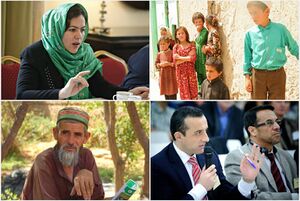
Paternal haplogroups
Regueiro et al (2006)[132] and Grugni et al (2012)[133] have performed large-scale sampling of Y chromosome haplogroups of different ethnic groups within Iran. They found that the most common paternal haplogroups were:
- J1-M267; commonly found among Semitic-speaking people, was rarely over 10% in Iranian groups.
- J2-M172: is the most common Hg in Iran (~23%); almost exclusively represented by J2a-M410 subclade (93%), the other major sub-clade being J2b-M12. Apart from Iranians, J2 is common in northern Arabs, Mediterranean and Balkan peoples (Croats, Serbs, Greeks, Bosniaks, Albanians, Italians, Macedonians, Bulgarians, Turks), in the Caucasus (Armenians, Georgians, Chechens, Ingush, northeastern Turkey, north/northwestern Iran, Kurds, Persians); whilst its frequency drops suddenly beyond Afghanistan, Pakistan and northern India.[134] In Europe, J2a is more common in southern Greece and southern Italy; whilst J2b (J2-M12) is more common in Thessaly, Macedonia and central – northern Italy. Thus J2a and its subgroups within it have a wide distribution from Italy to India, whilst J2b is mostly confined to the Balkans and Italy,[135] being rare even in Turkey. Whilst closely linked with Anatolia and the Levant; and putative agricultural expansions, the distribution of the various sub-clades of J2 likely represents a number of migrational histories which require further elucidation.[134][136]
- R1a-M198: is common in Iran, more so in the east and south rather than the west and north; suggesting a migration toward the south to India then a secondary westward spread across Iran.[137] Whilst the Grongi and Regueiro studies did not define exactly which sub-clades Iranian R1a haplogrouops belong to, private genealogy tests suggest that they virtually all belong to "Eurasian" R1a-Z93.[138] Indeed, population studies of neighbouring Indian groups found that they all were in R1a-Z93.[139] This implies that R1a in Iran did not descend from "European" R1a, or vice versa. Rather, both groups are collateral, brother branches which descend from a parental group hypothesized to have initially lived somewhere between central Asia and Eastern Europe.[139]
- R1b – M269: is widespread from Ireland to Iran, and is common in highland West Asian populations such as Armenians, Turks and Iranians – with an average frequency of 8.5%. Iranian R1b belongs to the L-23 subclade,[140] which is an older than the derivative subclade (R1b-M412) which is most common in western Europe.[141]
- Haplogroup G and subclades: most concentrated in the Caucasus,[142] it is present in 10% of Iranians.[133]
- Haplogroup E and various subclades are frequently found among Middle Easterners, Europeans, northern and eastern African populations. They are present in less than 10% of Iranians.
Two large – scale papers by Haber (2012)[143] and Di Cristofaro (2013)[144] analyzed populations from Afghanistan, where several Iranian-speaking groups are native. They found that different groups (e.g. Baluch, Hazara, Pashtun) were quite diverse, yet overall:
- R1a (subclade not further analyzed) was the predominant haplogroup, especially amongst Pashtuns, the Baloch and Tajiks.
- The presence of "East-Eurasian" haplogroup C3, especially in Hazaras (33–40%), in part linked to Mongol expansions into the region.
- The presence of haplogroup J2, like in Iran, of 5–20%.
- A relative paucity of "Indian" haplgroup H (< 10%).
A 2012 study by Grugni et al. analyzed the haplogroups of 15 different ethnic groups from Iran. They found that about 31.4% belong to J, 29.1% belong to R, 11.8% belong to G, and 9.2% belong to E. They found that Iranian ethnic groups display high haplogroup diversity, compared to other Middle Easterners. The authors concluded that the Iranian gene pool has been an important source for the Middle Eastern and Eurasian Y chromosome diversity, and the results suggest that there was already rather high Y chromosome diversity during the Neolithic period, placing Iranian populations in between Europeans, Middle Easterners and South Asians.[145]
انظر أيضاً
|
|
قراءات إضافية
- Banuazizi, Ali and Weiner, Myron (eds.). The State, Religion, and Ethnic Politics: Afghanistan, Iran, and Pakistan (Contemporary Issues in the Middle East), Syracuse University Press (August, 1988). ISBN 0-8156-2448-4.
- Canfield, Robert (ed.). Turko-Persia in Historical Perspective, Cambridge University Press, Cambridge (2002). ISBN 0-521-52291-9
- Curzon, R. The Iranian People of the Caucasus. ISBN 0-7007-0649-6.
- Derakhshani, Jahanshah. Die Arier in den nahöstlichen Quellen des 3. und 2. Jahrtausends v. Chr., 2nd edition (1999). ISBN 964-90368-6-5.
- Frye, Richard, Greater Iran, Mazda Publishers (2005). ISBN 1-56859-177-2.
- Frye, Richard. Persia, Schocken Books, Zurich (1963). ASIN B0006BYXHY.
- Kennedy, Hugh. The Prophet and the Age of the Caliphates, Longman, New York, NY (2004). ISBN 0-582-40525-4
- Khoury, Philip S. & Kostiner, Joseph. Tribes and State Formation in the Middle East, University of California Press (1991). ISBN 0-520-07080-1.
- Littleton, C. & Malcor, L. From Scythia to Camelot, Garland Publishing, New York, NY, (2000). ISBN 0-8153-3566-0.
- Mallory, J.P. In Search of the Indo-Europeans, Thames and Hudson, London (1991). ISBN 0-500-27616-1.
- McDowall, David. A Modern History of the Kurds, I.B. Tauris, 3rd Rev edition (2004). ISBN 1-85043-416-6.
- Nassim, J. Afghanistan: A Nation of Minorities, Minority Rights Group, London (1992). ISBN 0-946690-76-6.
- Riasanovsky, Nicholas. A History of Russia, Oxford University Press, Oxford (2004). ISBN 0-19-515394-4.
- Sims-Williams, Nicholas. Indo-Iranian Languages and People, British Academy (2003). ISBN 0-19-726285-6.
- Iran Nama, (Iran Travelogue in Urdu) by Hakim Syed Zillur Rahman, Tibbi Academy, Aligarh, India (1998).
- Saga of the Aryans, Historical novel on ancient Iranian migrations by Porus Homi Havewala, Published Mumbai, India (2005, 2010).
- Chopra, R. M.,"Indo-Iranian Cultural Relations Through The Ages", Iran Society, Kolkata, 2005.
Notes
- ^ In the Avesta the airiia- are members of the ethnic group of the Avesta-reciters themselves, in contradistinction to the anairiia-, the "non-Aryas". The word also appears four times in Old Persian: One is in the Behistun inscription, where ariya- is the name of a language or script (DB 4.89). The other three instances occur in Darius I's inscription at Naqsh-e Rustam (DNa 14–15), in Darius I's inscription at Susa (DSe 13–14), and in the inscription of Xerxes I at Persepolis (XPh 12–13). In these, the two Achaemenid dynasts describe themselves as pārsa pārsahyā puça ariya ariyaciça "a Persian, son of a Persian, an Ariya, of Ariya origin." "The phrase with ciça, "origin, descendance", assures that it [i.e. ariya] is an ethnic name wider in meaning than pārsa and not a simple adjectival epithet".[28]
- ^ See also: Origin hypotheses of the Serbs and Origin hypotheses of the Croats
المصادر
- ^ The Ossetians of the Caucasus are Orthodox Christians
- ^
- Iran: Library of Congress, Library of Congress – Federal Research Division. "Ethnic Groups and Languages of Iran" (PDF). Retrieved 2009-12-02. (Persian and Caspian dialects-65% Kurdish 8%-Luri/Bakhtiari 5%- Baluchi 2%):80% of the population or approximately 63 million people.
- Afghanistan: CIA Factbook Afghanistan: unting Pashtuns, Tajiks, Baluchs, 21 million
- Tajiks of Central Asia counting Tajikistan and Uzbekistan 10–15 million
- Kurds and Zazas of Turkey, Syria, Lebanon and Iraq based on CIA factbook estimate 22 million
- Ossetians, Talysh, Tats, Kurds of the Caucasus and Central Asia: 1–2 million based on CIA factbook/ethnologue.
- طاجيك الصين: 50,000 إلى 100,000
- المتحدثون بالإيرانية في البحرين، الخليج الغربي، غرب اوروپا والولايات المتحدة 3 مليون.
- Pakistan counting Baluchis+Pashtus+Afghan refugees based on CIA factbook and other sources: 35 مليون .
- ^ R.N Frye, "IRAN v. PEOPLE OF IRAN" in Encycloapedia Iranica. "In the following discussion of "Iranian people," the term "Iranian" may be understood in two ways. It is, first of all, a linguistic classification, intended to designate any society which inherited or adopted, and transmitted, an Iranian language. The set of Iranian-speaking peoples is thus considered a kind of unity, in spite of their distinct lineage identities plus all the factors which may have further differentiated any one group’s sense of self."
- ^ J. Harmatta in "History of Civilizations of Central Asia", Chapter 14, The Emergence of Indo-Iranians: The Indo-Iranian Languages, ed. by A. H. Dani & V.N. Masson, 1999, p. 357
- ^ Ronald Eric Emmerick. "Iranian languages". Encyclopedia Britanica. Retrieved Feb. 6, 2011.
{{cite web}}: Check date values in:|accessdate=(help) - ^ PRODS OKTOR SKJÆRVØ (December 15, 2006). "Iran vi. Iranian languages and scripts". Encylopedia Iranica.
{{cite web}}:|access-date=requires|url=(help); Check date values in:|accessdate=(help); Missing or empty|url=(help) - ^ Frye, Richard Nelson, Greater Iran, ISBN 1-56859-177-2 p.xi: "... Iran means all lands and people where Iranian languages were and are spoken, and where in the past, multi-faceted Iranian cultures existed. ..."
- ^ Beckwith 2009, pp. 58–77
- ^ Mallory 1997, pp. 308–311
- ^ Harmatta 1992, p. 348: "منذ الألفية الأولى ق.م.، لدينا مصادر تاريخية وأثرية ولغوية وفيرة لموقع المنطقة التي سكنتها الشعوب الإيرانية. في هذه الفترة، امتدت أراضي الإيرانيين الشماليين، الذين كانوا من البدو الرحل، على كامل منطقة السهوب والسهوب المشجرة وحتى شبه الصحاري من السهل المجري العظيم إلى أوردوس في شمال الصين."
- ^ "A Persian view of Steppe Iranians". ResearchGate (in الإنجليزية). Retrieved 10 August 2019.
- ^ أ ب Brzezinski, Richard; Mielczarek, Mariusz (2002). The Sarmatians, 600 BC-AD 450. Osprey Publishing. p. 39.
(...) Indeed, it is now accepted that the Sarmatians merged in with pre-Slavic populations.
- ^ أ ب ت Adams, Douglas Q. (1997). Encyclopedia of Indo-European Culture. Taylor & Francis. p. 523.
(...) In their Ukrainian and Polish homeland the Slavs were intermixed and at times overlain by Germanic speakers (the Goths) and by Iranian speakers (Scythians, Sarmatians, Alans) in a shifting array of tribal and national configurations.
- ^ أ ب Atkinson, Dorothy; Dallin, Alexander; Lapidus, Gail Warshofsky, eds. (1977). Women in Russia. Stanford University Press. p. 3. ISBN 978-0-8047-0910-1.
(...) Ancient accounts link the Amazons with the Scythians and the Sarmatians, who successively dominated the south of Russia for a millennium extending back to the seventh century B.C. The descendants of these peoples were absorbed by the Slavs who came to be known as Russians.
- ^ أ ب ت Slovene Studies. Vol. 9–11. Society for Slovene Studies. 1987. p. 36.
(...) For example, the ancient Scythians, Sarmatians (amongst others) and many other attested but now extinct peoples were assimilated in the course of history by Proto-Slavs.
- ^ Roy, Olivier (2007). The New Central Asia: Geopolitics and the Birth of Nations. I.B. Tauris. p. 6. ISBN 978-1-84511-552-4.
The mass of the Oghuz who crossed the Amu Darya towards the west left the Iranian Plateau, which remained Persian and established themselves more to the west, in Anatolia. Here they divided into Ottomans, who were Sunni and settled, and Turkmens, who were nomads and in part Shiite (or, rather, Alevi). The latter were to keep the name 'Turkmen' for a long time: from the thirteenth century onwards they 'Turkised' the Iranian populations of Azerbaijan (who spoke west Iranian languages such as Tat, which is still found in residual forms), thus creating a new identity based on Shiism and the use of Turkish. These are the people today known as Azeris.
- ^ Yarshater, Ehsan (15 December 1988). "AZERBAIJAN vii. The Iranian Language of Azerbaijan". Encyclopædia Iranica.
- ^ Emmerick, Ronald Eric (23 February 2016). "Iranian languages". Encyclopædia Britannica. Retrieved 9 September 2018.
- ^ Frye, Richard Nelson (2005). Greater Iran. p. xi. ISBN 978-1-56859-177-3.
(...) Iran means all lands and people where Iranian languages were and are spoken, and where in the past, multi-faceted Iranian cultures existed.
- ^ أ ب ت MacKenzie, David Niel (1998). "Ērān, Ērānšahr". Encyclopedia Iranica. Vol. 8. Costa Mesa: Mazda. Archived from the original on 13 March 2017. Retrieved 15 January 2012.
- ^ Schmitt, Rüdiger (1987), "Aryans", Encyclopedia Iranica, 2, New York: Routledge & Kegan Paul, pp. 684–687
- ^ Laroche. 1957. Proto-Iranian *arya- descends from Proto-Indo-European (PIE) *ar-yo-, a yo-adjective to a root *ar "to assemble skillfully", present in Greek harma "chariot", Greek aristos, (as in "aristocracy"), Latin ars "art", etc.
- ^ G. Gnoli, "Iranian Identity as a Historical Problem: the Beginnings of a National Awareness under the Achaemenians," in The East and the Meaning of History. International Conference (23–27 November 1992), Roma, 1994, pp. 147–67.
- ^ أ ب ت ث ج ح خ د Gnoli, G. "Iranian Identity ii. Pre-Islamic Period". Encyclopedia Iranica. Retrieved 3 February 2019.
- ^ أ ب ت H. W. Bailey, "Arya" in Encyclopedia Iranica. Excerpt: "ARYA an ethnic epithet in the Achaemenid inscriptions and in the Zoroastrian Avestan tradition. "Arya an ethnic epithet in the Achaemenid inscriptions and in the Zoroastrian Avestan tradition". Archived from the original on 3 January 2013. Also accessed online in May 2010.
- ^ Dalby, Andrew (2004), Dictionary of Languages, Bloomsbury, ISBN 0-7475-7683-1
- ^ G. Gnoli. "ēr, ēr mazdēsn". Encyclopedia Iranica.
- ^ أ ب Bailey, Harold Walter (1987). "Arya". Encyclopedia Iranica. Vol. 2. New York: Routledge & Kegan Paul. pp. 681–683. Archived from the original on 3 March 2016. Retrieved 15 January 2012.
- ^ cf. Gershevitch, Ilya (1968). "Old Iranian Literature". Handbuch der Orientalistik, Literatur I. Leiden: Brill. pp. 1–31., p. 2.
- ^ أ ب ت R. G. Kent. Old Persian. Grammar, texts, lexicon. 2nd ed., New Haven, Conn.
- ^ Lazard, G. (1975). "The Rise of the New Persian Language". The Cambridge History of Iran. pp. 595–632. doi:10.1017/CHOL9780521200936.021. ISBN 978-1-139-05496-6.
- ^ MacKenzie D.N. Corpus inscriptionum Iranicarum Part. 2., inscription of the Seleucid and Parthian periods of Eastern Iran and Central Asia. Vol. 2. Parthian, London, P. Lund, Humphries 1976–2001
- ^ أ ب
 Meyer, Eduard (1911). . In Chisholm, Hugh (ed.). دائرة المعارف البريطانية. Vol. 742 (eleventh ed.). Cambridge University Press. p. 742.
Meyer, Eduard (1911). . In Chisholm, Hugh (ed.). دائرة المعارف البريطانية. Vol. 742 (eleventh ed.). Cambridge University Press. p. 742. {{cite encyclopedia}}: Cite has empty unknown parameter:|coauthors=(help) - ^ R.W. Thomson. History of Armenians by Moses Khorenat’si. Harvard University Press, 1978. Pg 118, pg 166
- ^ The "Aryan" Language, Gherardo Gnoli, Instituto Italiano per l'Africa e l'Oriente, Roma, 2002
- ^ N. Sims-Williams, "Further notes on the Bactrian inscription of Rabatak, with the Appendix on the name of Kujula Kadphises and VimTatku in Chinese". Proceedings of the Third European Conference of Iranian Studies (Cambridge, September 1995). Part 1: Old and Middle Iranian<Studies, N. Sims-Williams, ed. Wiesbaden, pp 79-92
- ^ Perry, John R. (1998). "Languages and Dialects: Islamic Period". Iranian Studies. 31 (3/4): 517–525. doi:10.1080/00210869808701929. JSTOR 4311186.
- ^ Kümmel, Martin Joachim. "Iranic vs. Iranian." Update of Mar 30 (2018).
- ^ Burrow 1973.
- ^ Parpola 1999.
- ^ أ ب Beckwith 2009.
- ^ Anthony 2007, p. 408.
- ^ Beckwith 2009, p. 33 note 20, p.35.
- ^ أ ب Beckwith 2009, p. 33.
- ^ Anthony 2007, p. 454.
- ^ Beckwith 2009, p. 33 note 20.
- ^ Beckwith 2009, p. 376-7.
- ^ Mallory 1989, pp. 42–43.
- ^ أ ب Koryakova 1998b.
- ^ أ ب Koryakova 1998a.
- ^ Anthony 2009.
- ^ Anthony 2009, p. 390 (fig. 15.9), 405–411.
- ^ Anthony 2007, pp. 385–388.
- ^ Allentoft, Morten E.; Sikora, Martin; Sjögren, Karl-Göran; Rasmussen, Simon; Rasmussen, Morten; Stenderup, Jesper; Damgaard, Peter B.; Schroeder, Hannes; Ahlström, Torbjörn; Vinner, Lasse; Malaspinas, Anna-Sapfo; Margaryan, Ashot; Higham, Tom; Chivall, David; Lynnerup, Niels; Harvig, Lise; Baron, Justyna; Casa, Philippe Della; Dąbrowski, Paweł; Duffy, Paul R.; Ebel, Alexander V.; Epimakhov, Andrey; Frei, Karin; Furmanek, Mirosław; Gralak, Tomasz; Gromov, Andrey; Gronkiewicz, Stanisław; Grupe, Gisela; Hajdu, Tamás; Jarysz, Radosław; Khartanovich, Valeri; Khokhlov, Alexandr; Kiss, Viktória; Kolář, Jan; Kriiska, Aivar; Lasak, Irena; Longhi, Cristina; McGlynn, George; Merkevicius, Algimantas; Merkyte, Inga; Metspalu, Mait; Mkrtchyan, Ruzan; Moiseyev, Vyacheslav; Paja, László; Pálfi, György; Pokutta, Dalia; Pospieszny, Łukasz; Price, T. Douglas; Saag, Lehti; Sablin, Mikhail; Shishlina, Natalia; Smrčka, Václav; Soenov, Vasilii I.; Szeverényi, Vajk; Tóth, Gusztáv; Trifanova, Synaru V.; Varul, Liivi; Vicze, Magdolna; Yepiskoposyan, Levon; Zhitenev, Vladislav; Orlando, Ludovic; Sicheritz-Pontén, Thomas; Brunak, Søren; Nielsen, Rasmus; Kristiansen, Kristian; Willerslev, Eske (11 June 2015). "Population genomics of Bronze Age Eurasia". Nature. 522 (7555): 167–172. Bibcode:2015Natur.522..167A. doi:10.1038/nature14507. PMID 26062507. S2CID 4399103.
- ^ Kuznetsov 2006.
- ^ Hanks & Linduff 2009.
- ^ Mallory 1997, pp. 20–21.
- ^ Diakonoff, Kuz'mina & Ivantchik 1995, p. 473.
- ^ أ ب Okladnikov, A. P. (1994), "Inner Asia at the dawn of history", The Cambridge history of early Inner Asia, Cambridge [u.a.]: Cambridge Univ. Press, pp. 83, ISBN 978-0-521-24304-9
- ^ Mallory 1989:62
- ^ "Amazons in the Scythia: new finds at the Middle Don, Southern Russia". Taylorandfrancis.metapress.com. Retrieved 21 June 2009.[dead link]
- ^ "Secrets of the Dead, Casefile: Amazon Warrior Women". Pbs.org. Archived from the original on 29 December 2013. Retrieved 21 June 2009.
- ^ Tim McNeese (November 2004). The Volga River. p. 14. ISBN 9780791082478. Retrieved 11 July 2018.
- ^ Carl Waldman, Catherine Mason. "Encyclopedia of European Peoples" Infobase Publishing, 2006. ISBN 1438129181 p 692
- ^ Prudence Jones. Nigel Pennick. "A History of Pagan Europe" Routledge, 11 okt. 2. ISBN 1136141804 p 10
- ^ Ion Grumeza "Dacia: Land of Transylvania, Cornerstone of Ancient Eastern Europe" University Press of America, 16 May 2009. ISBN 076184466X pp 19–21
- ^ Liverani, M. (1995). "The Medes at Esarhaddon's Court". Journal of Cuneiform Studies. 47: 57–62. doi:10.2307/1359815. JSTOR 1359815. S2CID 163290816.
- ^ "The Geography of Strabo" – University of Chicago. . Retrieved 4 June 2006.
- ^ A. Leo Oppenheim, Ancient Mesopotamia, 1964[استشهاد ناقص]
- ^ Schmitt Achaemenid dynasty (i. The clan and dynasty)
- ^ "Avestan xᵛarǝnah-, etymology and concept by Alexander Lubotsky" Archived 7 فبراير 2006 at the Wayback Machine – Sprache und Kultur. Akten der X. Fachtagung der Indogermanischen Gesellschaft, 22.-28. September 1996, ed. W. Meid, Innsbruck (IBS) 1998, 479–488. . Retrieved 4 June 2006.
- ^ R. G. Kent, Old Persian: Grammar, texts and lexicon.
- ^ R. Hallock (1969), Persepolis Fortification Tablets; A. L. Driver (1954), Aramaic Documents of the V Century BC.
- ^ أ ب ت ث Greek and Iranian, E. Tucker, A History of Ancient Greek: From the Beginnings to Late Antiquity, ed. Anastasios-Phoivos Christidēs, Maria Arapopoulou, Maria Chritē, (Cambridge University Press, 2001), 780.
- ^ "Kurdish: An Indo-European Language By Siamak Rezaei Durroei" Archived 17 يونيو 2006 at the Wayback Machine – University of Edinburgh, School of Informatics. . Retrieved 4 June 2006.
- ^ "The Iranian Language Family, Khodadad Rezakhani" Archived 9 أكتوبر 2004 at the Wayback Machine – Iranologie. . Retrieved 4 June 2006.
- ^ "Sarmatian". Encyclopædia Britannica Online. Retrieved 31 December 2014.
- ^ Apollonius (Argonautica, iii) envisaged the Sauromatai as the bitter foe of King Aietes of Colchis (modern Georgia).
- ^ Arrowsmith, A; Fellowes, B; Hansard, G L (1832). A Grammar of Ancient Geography,: Compiled for the Use of King's College School (3 April 2006 ed.). Hansard London. p. 9. Retrieved 20 August 2014.
Scythia square miles.
- ^ Arrowsmith, A; Fellowes, B; Hansard, G L (1832). A Grammar of Ancient Geography,: Compiled for the Use of King's College School (3 April 2006 ed.). Hansard London. p. 15. Retrieved 20 August 2014.
Scythia square miles.
- ^ Schenker (2008, p. 109)
- ^ Sussex & Cubberley (2011, pp. 111–112)
- ^ Cross, S. H. (1946). "Primitive Civilization of the Eastern Slavs". American Slavic and East European Review. 5 (1/2): 51–87. doi:10.2307/2491581. JSTOR 2491581.
- ^ أ ب A History of Russia by Nicholas Riasanovsky, pp. 11–18, Russia before the Russians, ISBN 0-19-515394-4 . Retrieved 4 June 2006.
- ^ The Sarmatians: 600 BC-AD 450 (Men-at-Arms) by Richard Brzezinski and Gerry Embleton, 19 August 2002
- ^ "Jeannine Davis-Kimball, Archaeologist" – Thirteen WNET New York. Retrieved 4 June 2006.
- ^ James Minahan, "One Europe, Many Nations", Published by Greenwood Publishing Group, 2000. pg 518: "The Ossetians, calling themselves Iristi and their homeland Iryston are the most northerly Iranian people. ... They are descended from a division of Sarmatians, the Alans who were pushed out of the Terek River lowlands and in the Caucasus foothills by invading Huns in the 4th century CE.
- ^ "Ossetians". Encarta. Microsoft Corporation. 2008.
- ^ From Scythia to Camelot by Littleton and Malcor, pp. 40–43, ISBN 0-8153-3566-0 . Retrieved 4 June 2006.
- ^ "Report for Talysh" – Ethnologue. Retrieved 4 June 2006.
- ^ "Report for Tats" – Ethnologue. . Retrieved 4 June 2006.
- ^ Damgaard, Peter de Barros; Marchi, Nina; Rasmussen, Simon; Peyrot, Michaël; Renaud, Gabriel; Korneliussen, Thorfinn; Moreno-Mayar, J. Víctor; Pedersen, Mikkel Winther; Goldberg, Amy; Usmanova, Emma; Baimukhanov, Nurbol (May 2018). "137 ancient human genomes from across the Eurasian steppes". Nature (in الإنجليزية). 557 (7705): 369–374. Bibcode:2018Natur.557..369D. doi:10.1038/s41586-018-0094-2. hdl:1887/3202709. ISSN 1476-4687. PMID 29743675. S2CID 13670282.
pp. 4–5. "The wide distribution of the Turkic languages from Northwest China, Mongolia and Siberia in the east to Turkey and Bulgaria in the west implies large-scale migrations out of the homeland in Mongolia.
- ^ Foltz, Richard (2022). The Ossetes: Modern-Day Scythians of the Caucasus. London: Bloomsbury. ISBN 9780755618453.
- ^ The Prophet and the Age of the Caliphates by Hugh Kennedy, ISBN 0-582-40525-4 (retrieved 4 June 2006), p. 135
- ^ Gordon, Raymond G. Jr. (2005). "Report for Iranian languages". Ethnologue: Languages of the World (Fifteenth ed.).
- ^ أ ب Hamzehʼee, M. Reza. The Yaresan: a sociological, historical and religio-historical study of a Kurdish community, 1990.
- ^ أ ب ت Planhol, Xavier de. "IRAN i. LANDS OF IRAN". Encyclopædia Iranica. Vol. XIII. pp. 204–212. Retrieved 30 December 2012.
- ^ Planhol, Xavier de (7 February 2012). "Evolution of geographical knowledge". Encyclopædia Iranica. Vol. X. pp. 426–431.
- ^ Mallory 1989, pp. 112–127.
- ^ أ ب خطأ استشهاد: وسم
<ref>غير صحيح؛ لا نص تم توفيره للمراجع المسماةpeoples survey - ^ Kleiss, Wolfram (20 April 2012). "KANGAVAR – Encyclopaedia Iranica". Encyclopædia Iranica. Vol. XV. pp. 496–497.
- ^ أ ب ت Malandra, William W. "Ancient Iranian religion". Encyclopædia Britannica. Retrieved 4 September 2018.
- ^ Duchesne-Guillemin, Jacques. "Zoroastrianism". Encyclopædia Britannica. Retrieved 4 September 2018.
- ^ Runciman, Steven (1982). The Medieval Manichee: A Study of the Christian Dualist Heresy. Cambridge University Press. ISBN 978-0-521-28926-9.
- ^ أ ب ت Steblin-Kamenskij, Ivan M. (30 December 2012). "CENTRAL ASIA xiii. Iranian Languages". Encyclopædia Iranica. Vol. V. pp. 223–226.
- ^ Nauta, Ane H. (1972). "Der Lautwandel von a > o and von a > ä in der özbekischen Schriftsprache" [The sound change from a> o and from a> ä in the written Özbek language]. Central Asiatic Journal (in الألمانية). 16 (2): 104–118. JSTOR 41926941.
- ^ Raun, A. (1969). Basic course in Uzbek. Bloomington.
- ^ Canfield, Robert L. (2002). Turko-Persia in Historical Perspective. Cambridge University Press. ISBN 978-0-521-52291-5.
- ^ Minorsky, V. "Azerbaijan". In Bearman, P.; Bianquis, Th.; Bosworth, C.E.; Donzel, E. van; Heinrichs, W.P. (eds.). Encyclopaedia of Islam. Brill.
- ^ Roy, Olivier (2007). The new Central Asia. I.B. Tauris. p. 6. ISBN 978-1-84511-552-4.
The mass of the Oghuz who crossed the Amu Darya towards the west left the Iranian Plateau, which remained Persian, and established themselves more to the west, in Anatolia. Here they divided into Ottomans, who were Sunni and settled, and Turkmens, who were nomads and in part Shiite (or, rather, Alevi). The latter were to keep the name 'Turkmen' for a long time: from the 13th century onwards they 'Turkised' the Iranian populations of Azerbaijan (who spoke west Iranian languages such as Tat, which is still found in residual forms), thus creating a new identity based on Shiism and the use of Turkish. These are the people today known as Azeris.
- ^ Yarshater, Ehsan (15 December 1988). "AZERBAIJAN vii. The Iranian Language of Azerbaijan". Encyclopædia Iranica. Retrieved 3 May 2015.
- ^ "Azerbaijani". Encyclopaedia Britannica. Retrieved 7 September 2018.
- ^ Yarshater, Ehsan (18 August 2011). "AZERBAIJAN vii. The Iranian Language of Azerbaijan". Encyclopædia Iranica. Vol. III. pp. 238–245.
- ^ "The Columbia Encyclopedia: Azerbaijan". Archived from the original on 17 May 2006.
- ^ Farjadian, S.; Ghaderi, A. (4 October 2007). "HLA class II similarities in Iranian Kurds and Azeris". International Journal of Immunogenetics. 34 (6): 457–463. doi:10.1111/j.1744-313x.2007.00723.x. ISSN 1744-3121. PMID 18001303. S2CID 22709345.
- ^ Malyarchuk, B. A.; Derenko, M. V.; Denisova, G. A.; Nassiri, M. R.; Rogaev, E. I. (1 April 2002). "Mitochondrial DNA Polymorphism in Populations of the Caspian Region and Southeastern Europe". Russian Journal of Genetics. 38 (4): 434–438. doi:10.1023/A:1015262522048. S2CID 19409969. Archived from the original on 6 June 2011.
- ^ Gabain, A. von (1945). Özbekische Grammatik. Leipzig and Vienna.
- ^ Bečka, J. "Tajik Literature from the 16th Century to the Present". In Rypka, J. (ed.). History of Iranian Literature. pp. 520–605.
- ^ Jung, A. (1983). Quellen der klassischen Musiktradition Mittelasiens: Die usbekisch-tadshikischen maqom-Zyklen und ihre Beziehung zu anderen regionalen maqam-Traditionen im Vorderen and Mittleren Orient (PhD). Berlin.
- ^ Levin, T. (1984). The Music and Tradition of the Bukharan Shashmaqam in Soviet Uzbekistan (PhD). Princeton. OCLC 24081562.
- ^ Zerjal, Tatiana; Wells, R. Spencer; Yuldasheva, Nadira; Ruzibakiev, Ruslan; Tyler-Smith, Chris (September 2002). "A Genetic Landscape Reshaped by Recent Events: Y-Chromosomal Insights into Central Asia". The American Journal of Human Genetics. 71 (3): 466–482. doi:10.1086/342096. PMC 419996. PMID 12145751.
- ^ Askarov, A.; Ahmadov, B. (20 January 1994). O'zbek Xalqning Kilib Chiqishi Torixi. O'zbekiston Ovozi.
- ^ Heyer, Evelyne; Balaresque, Patricia; Jobling, Mark A; Quintana-Murci, Lluis; Chaix, Raphaelle; Segurel, Laure; Aldashev, Almaz; Hegay, Tanya (2009-09-01). "Genetic diversity and the emergence of ethnic groups in Central Asia". BMC Genetics. 10: 49. doi:10.1186/1471-2156-10-49. PMC 2745423. PMID 19723301.
{{cite journal}}: CS1 maint: unflagged free DOI (link) - ^ Millward, James A.; Perdue, Peter C. (2004). "Chapter 2: Political and Cultural History of the Xinjiang Region through the Late Nineteenth Century". In Starr, S. Frederick (ed.). Xinjiang: China's Muslim Borderland. M.E. Sharpe. pp. 40–41. ISBN 978-0-7656-1318-9.
- ^ B. Campbell, Disappearing people? Indigenous groups and ethnic minorities in South and Central Asia in: Barbara Brower, Barbara Rose Johnston (Ed.) International Mountain Society, California, 2007
- ^ Kieffer, Charles M. "HAZĀRA" [iv. Hazāragi dialect]. Encyclopædia Iranica. Retrieved August 22, 2017.
- ^ Milanović, Miodrag (2008). Srpski stari vek. Beograd. p. 81.
- ^ Stagličić, Ivan (27 November 2008). "Ideja o iranskom podrijetlu traje preko dvjesto godina" [Idea about Iranian theory lasts over two hundred years]. Zadarski list (in الكرواتية). Zadar. Retrieved 15 March 2015.
- ^ "Baloch and Sindhis share historic ties". 26 May 2017.
- ^ "From Zardaris to Makranis: How the Baloch came to Sindh". 27 March 2014.
- ^ Mehrjoo, Zohreh; Fattahi, Zohreh; Beheshtian, Maryam; Mohseni, Marzieh; Poustchi, Hossein; Ardalani, Fariba; Jalalvand, Khadijeh; Arzhangi, Sanaz; Mohammadi, Zahra; Khoshbakht, Shahrouz; Najafi, Farid (2019-09-24). "Distinct genetic variation and heterogeneity of the Iranian population". PLOS Genetics (in الإنجليزية). 15 (9): e1008385. doi:10.1371/journal.pgen.1008385. ISSN 1553-7404. PMC 6759149. PMID 31550250.
Seven groups (Iranian Arabs, Azeris, Gilaks, Kurds, Mazanderanis, Lurs and Persians) strongly overlapped in their overall autosomal diversity in an MDS analysis (Fig 1B), suggesting the existence of a Central Iranian Cluster (CIC), notably also including Iranian Arabs and Azeris. On a global scale (Fig 2 including "Old World" populations only; see S2 Fig for all 1000G populations), CIC Iranians closely clustered with Europeans, while Iranian Turkmen showed similar yet distinct degrees of admixture compared to other South Asians. A local comparison corroborated the distinct genetic diversity of CIC Iranians relative to other geographically close populations [2, 6, 44] (Fig 3 and S3 Fig). Still, genetic substructure was much smaller among Iranian groups than in relation to any of the 1000G populations, supporting the view that the CIC groups form a distinct genetic entity, despite internal heterogeneity. European (FST~0.0105–0.0294), South Asians (FST~0.0141–0.0338), but also some Latin American populations (Puerto Ricans: FST~0.0153–0.0228; Colombians: FST~0.0170–0.0261) were closest to Iranians, whereas Sub-Saharan Africans and admixed Afro-Americans (FST~0.0764–0.1424) as well as East Asians (FST ~ 0.0645–0.1055) showed large degrees of differentiation with Iranians.
{{cite journal}}: CS1 maint: unflagged free DOI (link) - ^ Regueiro, M.; Cadenas, A.M.; Gayden, T.; Underhill, P.A.; Herrera, R.J. (2006). "Iran: Tricontinental Nexus for Y-Chromosome Driven Migration". Human Heredity. 61 (3): 132–143. doi:10.1159/000093774. PMID 16770078. S2CID 7017701.
- ^ أ ب Grugni, Viola; Battaglia, Vincenza; Hooshiar Kashani, Baharak; Parolo, Silvia; Al-Zahery, Nadia; Achilli, Alessandro; Olivieri, Anna; Gandini, Francesca; Houshmand, Massoud; Sanati, Mohammad Hossein; Torroni, Antonio; Semino, Ornella (18 July 2012). "Ancient Migratory Events in the Middle East: New Clues from the Y-Chromosome Variation of Modern Iranians". PLOS ONE. 7 (7): e41252. Bibcode:2012PLoSO...741252G. doi:10.1371/journal.pone.0041252. PMC 3399854. PMID 22815981.
- ^ أ ب Sengupta, Sanghamitra; Zhivotovsky, Lev A.; King, Roy; Mehdi, S. Q.; Edmonds, Christopher A.; Chow, Cheryl-Emiliane T.; Lin, Alice A.; Mitra, Mitashree; Sil, Samir K.; Ramesh, A.; Usha Rani, M. V.; Thakur, Chitra M.; Cavalli-Sforza, L. Luca; Majumder, Partha P.; Underhill, Peter A. (February 2006). "Polarity and Temporality of High-Resolution Y-Chromosome Distributions in India Identify Both Indigenous and Exogenous Expansions and Reveal Minor Genetic Influence of Central Asian Pastoralists". American Journal of Human Genetics. 78 (2): 202–221. doi:10.1086/499411. PMC 1380230. PMID 16400607.
- ^ Cinnioğlu, Cengiz; King, Roy; Kivisild, Toomas; Kalfoğlu, Ersi; Atasoy, Sevil; Cavalleri, Gianpiero L.; Lillie, Anita S.; Roseman, Charles C.; Lin, Alice A.; Prince, Kristina; Oefner, Peter J.; Shen, Peidong; Semino, Ornella; Cavalli-Sforza, L. Luca; Underhill, Peter A. (2004-01-01). "Excavating Y-chromosome haplotype strata in Anatolia". Human Genetics. 114 (2): 127–148. doi:10.1007/s00439-003-1031-4. PMID 14586639. S2CID 10763736.
- ^ Semino, Ornella; Magri, Chiara; Benuzzi, Giorgia; Lin, Alice A.; Al-Zahery, Nadia; Battaglia, Vincenza; Maccioni, Liliana; Triantaphyllidis, Costas; Shen, Peidong; Oefner, Peter J.; Zhivotovsky, Lev A.; King, Roy; Torroni, Antonio; Cavalli-Sforza, L. Luca; Underhill, Peter A.; Santachiara-Benerecetti, A. Silvana (May 2004). "Origin, Diffusion, and Differentiation of Y-Chromosome Haplogroups E and J: Inferences on the Neolithization of Europe and Later Migratory Events in the Mediterranean Area". The American Journal of Human Genetics. 74 (5): 1023–1034. doi:10.1086/386295. PMC 1181965. PMID 15069642.
- ^ Regueiro, 2006
- ^ "Family Tree DNA – Genetic Testing for Ancestry, Family History & Genealogy".
- ^ أ ب Pamjav, Horolma; Fehér, Tibor; Németh, Endre; Pádár, Zsolt (December 2012). "Brief communication: New Y-chromosome binary markers improve phylogenetic resolution within haplogroup R1a1". American Journal of Physical Anthropology. 149 (4): 611–615. doi:10.1002/ajpa.22167. PMID 23115110.
- ^ Grugni, 2013.[استشهاد ناقص]
- ^ Myres, Natalie M; Rootsi, Siiri; Lin, Alice A; Järve, Mari; King, Roy J; Kutuev, Ildus; Cabrera, Vicente M; Khusnutdinova, Elza K; Pshenichnov, Andrey; Yunusbayev, Bayazit; Balanovsky, Oleg; Balanovska, Elena; Rudan, Pavao; Baldovic, Marian; Herrera, Rene J; Chiaroni, Jacques; Di Cristofaro, Julie; Villems, Richard; Kivisild, Toomas; Underhill, Peter A (January 2011). "A major Y-chromosome haplogroup R1b Holocene era founder effect in Central and Western Europe". European Journal of Human Genetics. 19 (1): 95–101. doi:10.1038/ejhg.2010.146. PMC 3039512. PMID 20736979.
- ^ Rootsi, Siiri; Myres, Natalie M; Lin, Alice A; Järve, Mari; King, Roy J; Kutuev, Ildus; Cabrera, Vicente M; Khusnutdinova, Elza K; Varendi, Kärt; Sahakyan, Hovhannes; Behar, Doron M; Khusainova, Rita; Balanovsky, Oleg; Balanovska, Elena; Rudan, Pavao; Yepiskoposyan, Levon; Bahmanimehr, Ardeshir; Farjadian, Shirin; Kushniarevich, Alena; Herrera, Rene J; Grugni, Viola; Battaglia, Vincenza; Nici, Carmela; Crobu, Francesca; Karachanak, Sena; Kashani, Baharak Hooshiar; Houshmand, Massoud; Sanati, Mohammad H; Toncheva, Draga; Lisa, Antonella; Semino, Ornella; Chiaroni, Jacques; Cristofaro, Julie Di; Villems, Richard; Kivisild, Toomas; Underhill, Peter A (December 2012). "Distinguishing the co-ancestries of haplogroup G Y-chromosomes in the populations of Europe and the Caucasus". European Journal of Human Genetics. 20 (12): 1275–1282. doi:10.1038/ejhg.2012.86. PMC 3499744. PMID 22588667.
- ^ Haber, Marc; Platt, Daniel E.; Ashrafian Bonab, Maziar; Youhanna, Sonia C.; Soria-Hernanz, David F.; Martínez-Cruz, Begoña; Douaihy, Bouchra; Ghassibe-Sabbagh, Michella; Rafatpanah, Hoshang; Ghanbari, Mohsen; Whale, John; Balanovsky, Oleg; Wells, R. Spencer; Comas, David; Tyler-Smith, Chris; Zalloua, Pierre A. (28 March 2012). "Afghanistan's Ethnic Groups Share a Y-Chromosomal Heritage Structured by Historical Events". PLOS ONE. 7 (3): e34288. Bibcode:2012PLoSO...734288H. doi:10.1371/journal.pone.0034288. PMC 3314501. PMID 22470552.
- ^ Di Cristofaro, Julie; Pennarun, Erwan; Mazières, Stéphane; Myres, Natalie M.; Lin, Alice A.; Temori, Shah Aga; Metspalu, Mait; Metspalu, Ene; Witzel, Michael; King, Roy J.; Underhill, Peter A.; Villems, Richard; Chiaroni, Jacques (18 October 2013). "Afghan Hindu Kush: Where Eurasian Sub-Continent Gene Flows Converge". PLOS ONE. 8 (10): e76748. Bibcode:2013PLoSO...876748D. doi:10.1371/journal.pone.0076748. PMC 3799995. PMID 24204668.
- ^ Grugni, Viola; Battaglia, Vincenza; Hooshiar Kashani, Baharak; Parolo, Silvia; Al-Zahery, Nadia; Achilli, Alessandro; Olivieri, Anna; Gandini, Francesca; Houshmand, Massoud; Sanati, Mohammad Hossein; Torroni, Antonio (2012-07-18). "Ancient Migratory Events in the Middle East: New Clues from the Y-Chromosome Variation of Modern Iranians". PLOS ONE. 7 (7): e41252. Bibcode:2012PLoSO...741252G. doi:10.1371/journal.pone.0041252. ISSN 1932-6203. PMC 3399854. PMID 22815981.
وصلات خارجية
- Encyclopædia Britannica: Iranian languages
- The Changing Face of Iran a photo essay by Newsweek Magazine
- Maps and demographic information on all the people groups of Iran found at www.EveryTongue.com/iran
- CS1 errors: requires URL
- CS1 errors: access-date without URL
- مقالات المعرفة المحتوية على معلومات من دائرة المعارف البريطانية طبعة 1911
- Harv and Sfn no-target errors
- Articles with dead external links from April 2018
- Articles with incomplete citations from June 2014
- All articles with incomplete citations
- CS1 الألمانية-language sources (de)
- CS1 maint: unflagged free DOI
- CS1 الكرواتية-language sources (hr)
- Articles with incomplete citations from June 2021
- Short description is different from Wikidata
- Articles with hatnote templates targeting a nonexistent page
- Missing redirects
- "Related ethnic groups" needing confirmation
- Pages using infobox ethnic group with unsupported parameters
- Articles using infobox ethnic group with image parameters
- Articles containing Middle Persian-language text
- Articles containing فارسية قديمة (ح. 600-400 ق.م.)-language text
- Articles containing آڤستان-language text
- Articles containing سنسكريتية-language text
- Pages using gadget WikiMiniAtlas
- Articles with unsourced statements from February 2019
- Articles with unsourced statements from August 2021
- مقالات بالمعرفة بحاجة لذكر رقم الصفحة بالمصدر from November 2020
- Articles containing سندي-language text
- Iranian peoples
- Indo-European peoples
- Modern Indo-European peoples
- Ethnic groups in the Middle East
- إيرانيون
- جماعات عرقية في الشرق الأوسط
- شعوب قديمة
- شعوب هندية اوروبية



















